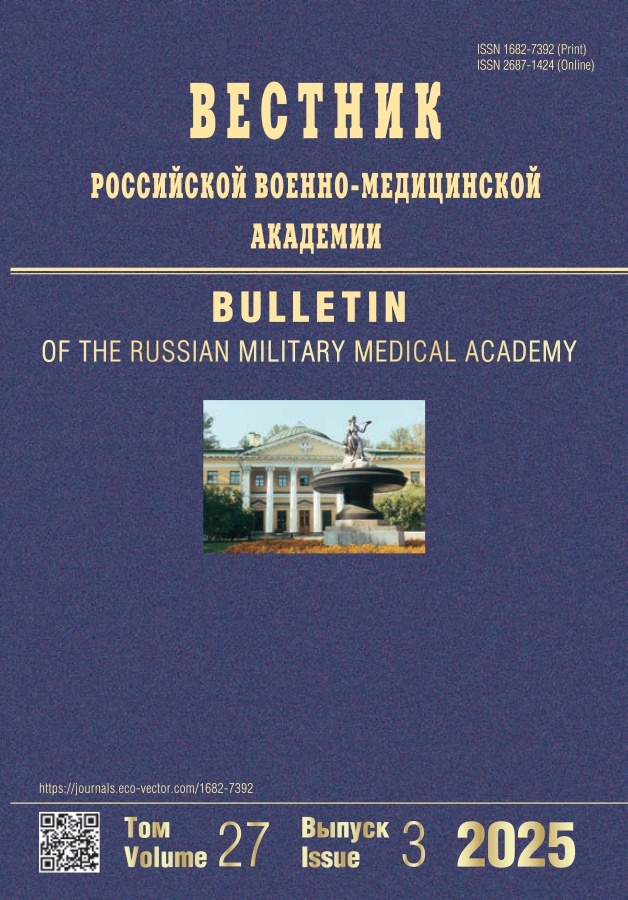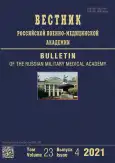Моноцитоз у больных коронавирусной пневмонией, на фоне лечения глюкокортикоидами
- Авторы: Шперлинг М.И.1, Ковалев А.В.1, Сукачев В.С.1, Власов А.А.2, Поляков А.С.1, Носков Я.А.1, Морозов А.Д.1, Мерзляков В.С.1, Звягинцев Д.П.1, Козлов К.В.1, Жданов К.В.1
-
Учреждения:
- Военно-медицинская академия имени С.М. Кирова МО РФ
- 33-й Центральный научно-исследовательский испытательный институт
- Выпуск: Том 23, № 4 (2021)
- Страницы: 105-112
- Раздел: Клинические исследования
- URL: https://journal-vniispk.ru/1682-7392/article/view/83090
- DOI: https://doi.org/10.17816/brmma83090
- ID: 83090
Цитировать
Аннотация
Исследованы особенности изменения параметров лейкоцитарной формулы периферической крови у 86 больных коронавирусной пневмонией с лейкоцитозом на фоне лечения глюкокортикоидами. Все больные были разделены на 2 группы. 1-ю группу составили 22 человека, у которых имелись клинические признаки бактериальной инфекции (кашель с гнойной мокротой в сочетании с нейтрофильным лейкоцитозом при поступлении в стационар). 2-ю группу составили 64 пациента с развившимся на фоне лечения глюкокортикоидами (дексаметазон 20 мг/сут или преднизолон 150 мг/сут, внутривенно в течение 3 дней) лейкоцитозом выше 10 × 109/л без признаков бактериальной инфекции. Установлено, что у пациентов 1-й группы по сравнению со 2-й группой уровни лейкоцитов и нейтрофилов значимо (p < 0,001) превышали референтные значения при отсутствии значимых изменений по количеству моноцитов. У больных 2-й группы после трехдневного внутривенного применения глюкокортикоидов на 4 сутки госпитализации установлено статистически значимое (p < 0,001) увеличение количества нейтрофилов и моноцитов. При сравнении количественных параметров лейкоцитарной формулы между 2-й группой на 4-е сутки госпитализации и 1-й группой при поступлении установлено отсутствие отличий по уровню лейкоцитов и нейтрофилов. Число моноцитов во 2-й группе (1,11 (0,90; 1,34) × 109/л), напротив, статистически значимо (p < 0,001) превышало их уровень в 1-й группе (0,59 (0,50; 0,77) × 109/л). Таким образом, показатель количества моноцитов в периферической крови может быть перспективным дифференциально-диагностическим критерием генеза лейкоцитоза у пациентов, болеющих COVID-19. Данный параметр может являться одним из факторов, влияющих на принятие решения о назначении антибактериальной терапии.
Полный текст
Открыть статью на сайте журналаОб авторах
Максим Игоревич Шперлинг
Военно-медицинская академия имени С.М. Кирова МО РФ
Автор, ответственный за переписку.
Email: mersisaid@yandex.ru
ORCID iD: 0000-0002-3274-2290
SPIN-код: 7658-7348
Scopus Author ID: 57215661145
ResearcherId: ABC-3170-2021
ординатор
Россия, Санкт-ПетербургАлексей Викторович Ковалев
Военно-медицинская академия имени С.М. Кирова МО РФ
Email: kovalev.mmeda@yandex.ru
SPIN-код: 3478-3858
ординатор
Россия, Санкт-ПетербургВиталий Сергеевич Сукачев
Военно-медицинская академия имени С.М. Кирова МО РФ
Email: dr.sukachev@gmail.com
SPIN-код: 4140-6250
Scopus Author ID: 54890504800
ResearcherId: H-6303-2016
кандидат медицинских наук
Россия, Санкт-ПетербургАндрей Александрович Власов
33-й Центральный научно-исследовательский испытательный институт
Email: vlasovandrej@mail.ru
SPIN-код: 2801-1228
кандидат медицинских наук
Россия, Вольск-18Алексей Сергеевич Поляков
Военно-медицинская академия имени С.М. Кирова МО РФ
Email: doctorpolyakov@gmail.com
ORCID iD: 0000-0001-9238-8476
SPIN-код: 2700-2420
Scopus Author ID: 56583551700
ResearcherId: M-4229-2016
кандидат медицинских наук
Россия, Санкт-ПетербургЯрослав Алексеевич Носков
Военно-медицинская академия имени С.М. Кирова МО РФ
Email: dady-08@mail.ru
SPIN-код: 1645-2231
кандидат медицинских наук
Россия, Санкт-ПетербургАлександр Дмитриевич Морозов
Военно-медицинская академия имени С.М. Кирова МО РФ
Email: m14232@mail.ru
ORCID iD: 0000-0002-2258-5914
SPIN-код: 3874-8152
кандидат медицинских наук
Россия, Санкт-ПетербургВиктор Сергеевич Мерзляков
Военно-медицинская академия имени С.М. Кирова МО РФ
Email: sidmma@yandex.ru
SPIN-код: 5098-0700
курсант
Россия, Санкт-ПетербургДмитрий Петрович Звягинцев
Военно-медицинская академия имени С.М. Кирова МО РФ
Email: zvyagintsev321@mail.ru
SPIN-код: 9937-6852
курсант
Россия, Санкт-ПетербургКонстантин Вадимович Козлов
Военно-медицинская академия имени С.М. Кирова МО РФ
Email: kosttiak@mail.ru
ORCID iD: 0000-0002-4398-7525
SPIN-код: 7927-9076
Scopus Author ID: 56924908500
ResearcherId: H-9944-2013
доктор медицинских наук, профессор
Россия, Санкт-ПетербургКонстантин Валерьевич Жданов
Военно-медицинская академия имени С.М. Кирова МО РФ
Email: zhdanovkv.vma@gmail.com
SPIN-код: 7895-2075
Scopus Author ID: 6602691874
доктор медицинских наук профессор
Россия, Санкт-ПетербургСписок литературы
- Surveillances V. The Epidemiological Characteristics of an Outbreak of 2019 Novel Coronavirus Diseases (COVID-19) // Zhonghua Liu Xing Bing Xue Za Zhi. 2020. Vol. 41, No. 2. P. 145–151. doi: 10.3760/cma.j.issn.0254-6450.2020.02.003
- Зайцев А.А. Чернов С.А., Крюков Е.В., и др. Практический опыт ведения пациентов с новой коронавирусной инфекцией COVID-19 в стационаре (предварительные итоги и рекомендации) // Лечащий врач. 2020. № 6. С. 74–79. doi: 10.26295/OS.2020.41.94.014
- Teuwen L.A., Geldhof V., Pasut A., et al. COVID-19: the vasculature unleashed // Nat Rev Immunol. 2020. Vol. 20, No. 7. P. 389–391. doi: 10.1038/s41577-020-0343-0
- Azkur A.K., Akdis M., Azkur D., et al. Immune response to SARS-CoV-2 and mechanisms of immunopathological changes in COVID-19 // Allergy. 2020. Vol. 75, No. 7. P. 1564–1581. doi: 10.1111/all.14364
- Миннуллин Т.И., Степанов А.В., Чепур С.В., и др. Иммунологические аспекты поражения коронавирусом SARS-CoV-2 // Вестник Российской военно-медицинской академии. 2021. Т. 23, № 2. C. 187–198. doi: 10.17816/brmma72051
- Wang J., Jiang M., Chen X., et al. Cytokine storm and leukocyte changes in mild versus severe SARS-CoV-2 infection: Review of 3939 COVID-19 patients in China and emerging pathogenesis and therapy concepts // J Leukoc Biol. 2020. Vol. 108, No. 1. P. 17–41. doi: 10.1002/JLB.3COVR0520-272R
- Lansbury L., Lim B., Baskaran V., Lim W.S. Co-infections in people with COVID-19: a systematic review and meta-analysis // J Infect. 2020. Vol. 81, No. 2. P. 266–275. doi: 10.1016/j.jinf.2020.05.046
- Youngs J., Wyncoll D., Hopkins P., et al. Improving antibiotic stewardship in COVID-19: Bacterial co-infection is less common than with influenza // J Infect. 2020. Vol. 81. No. 3. P. e55–e57. doi: 10.1016/j.jinf.2020.06.056
- Crotty M.P., Akins R., Nguyen A., et al. Investigation of subsequent and co-infections associated with SARS-CoV-2 (COVID-19) in hospitalized patients // medRxiv. 2020. Vol. 2. P. 1–19. doi: 10.1101/2020.05.29.20117176
- Vazzana N., Dipaola F., Ognibene S. Procalcitonin and secondary bacterial infections in COVID-19: association with disease severity and outcomes // Acta Clin Belgica Int J Clin Lab Med. 2020. P. 1–5. doi: 10.1080/17843286.2020.1824749
- Зайцев А.А., Чернов С.А., Стец В.В., и др. Алгоритмы ведения пациентов с новой коронавирусной инфекцией COVID-19 в стационаре. Методические рекомендации // Consilium Medicum. 2020. Т. 22, № 11. С. 91–97. doi: 10.26442/20751753.2020.11.200520
- Lee H. Procalcitonin as a biomarker of infectious diseases // Korean J Intern Med. 2013. Vol. 28, No. 3. P. 285–291. doi: 10.3904/kjim.2013.28.3.285
- Shoenfeld Y., Gurewich Y., Gallant L.A., et al. Prednisone-induced leukocytosis // Am J Med. 1981. Vol. 71, No. 5. P. 773–778. doi: 10.1016/0002-9343(81)90363-6
- Martinez F.O., Combes T.W., Orsenigo F., et al. Monocyte activation in systemic Covid-19 infection: Assay and rationale // EBioMedicine. 2020. Vol. 59, No. 102964. P. 1–7. doi: 10.1016/j.ebiom.2020.102964
- Зайцев А.А., Голухова Е.З., Мамалыга М.Л., и др. Эффективность пульс-терапии метилпреднизолоном у пациентов с COVID-19 // Клиническая микробиология и антимикробная химиотерапия. 2020. Т. 22, № 2. С. 88–91. doi: 10.36488/cmac.2020.2.88-91
- Dubinski D., Won S.Y., Gessler F., et al. Dexamethasone-induced leukocytosis is associated with poor survival in newly diagnosed glioblastoma // J Neurooncol. 2018. Vol. 137, No. 3. P. 503–510. doi: 10.1007/s11060-018-2761-4
- Liles W.C., Dale D.C., Klebanoff S.J. Glucocorticoids inhibit apoptosis of human neutrophils // Blood. 1995. Vol. 86, No. 8. P. 3181–3188.
- Burton J.L., Kehrli M.E., Kapil S., et al. Regulation of l-selectin and CD18 on bovine neutrophils by glucocorticoids: effects of cortisol and dexamethasone // J Leukoc Biol. 1995. Vol. 57, No. 2. P. 317–325. doi: 10.1002/jlb.57.2.317
- Ehrchen J.M., RothJ., Barczyk-Kahlert K. More Than Suppression: Glucocorticoid Action on Monocytes and Macrophages // Front Immunol. 2019. Vol. 10. P. 2028. doi: 10.3389/fimmu.2019.02028
- Gómez-Rial J., Rivero-Calle I., Salas A. Role of Monocytes/Macrophages in COVID-19 Pathogenesis: Implications for Therapy // Infect Drug Resist. 2020. No. 13. P. 2485–2493. doi: 10.2147/IDR.S258639
- Qin C., Zhou L., Hu Z., et al. Dysregulation of Immune Response in Patients With Coronavirus 2019 (COVID-19) in Wuhan, China // Clin Infect Dis. 2020. Vol. 71. No. 15. P. 762–768. doi: 10.1093/cid/ciaa248
- Solinas C., Perra L., Aiello M., et al. A critical evaluation of glucocorticoids in the management of severe COVID-19 // Cytokine Growth Factor Rev. 2020. No. 54. P. 8–23. doi: 10.1016/j.cytogfr.2020.06.012
- Liu B., Dhanda A., Hirani S., et al. CD14++CD16+ Monocytes Are Enriched by Glucocorticoid Treatment and Are Functionally Attenuated in Driving Effector T Cell Responses // J Immunol. 2015. Vol. 194, No. 11. P. 5150–5160. doi: 10.4049/jimmunol.1402409
- Соломай Т.В., Семененко Т.А., Филатов Н.Н., и др. Реактивация инфекции, вызванной вирусом Эпштейна–Барр (Herpesviridae: Lymphocryptovirus, HHV-4) на фоне COVID-19: эпидемиологические особенности // Вопросы вирусологии. 2021. Т. 66, № 2. С. 152–161. doi: 10.36233/0507-4088-40
- Блинов Д.В., Акарачкова Е.С., Орлова А.С., и др. Новая концепция разработки клинических рекомендаций в России // Фармакоэкономика. Современная фармакоэкономика и фармакоэпидемиология. 2019. Т. 12, № 2. С. 125–144. doi: 10.17749/2070-4909.2019.12.2.125-144
Дополнительные файлы










